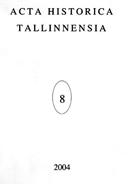Tööstustööliste töö- ja puhkeaeg ja selle seadusandlik reguleerimine eestis 1870–1940
Hours Of Work And Holidays In Estonian Industries And The Relevant Legislation, 1870–1940
Author(s): Maie PihlamägiSubject(s): History
Published by: Teaduste Akadeemia Kirjastus
Keywords: Estonia; Estonian History; Work ; Holidays ; Estonian Industries ; Legislation; 1870–1940
Summary/Abstract: As mechanised industry required few skills, there was an abundance of work force. In the 1860s and 1870s, the wages remained low and the working day lasted 14–16 hours. There was no insurance against accident, sickness or old age. The absence of social reforms led to various protests by workers. The main way through which the workers protested against the injustice of the employers and improved their status was striking movement. While the workers were helping themselves, the government also did its share through legislation. As government officials were well informed about the relevant laws in the leading industrial countries, the first factory act, passed in June 1882, forbade the employment of children under 12, limited the working hours of teenagers between 12 and 15 to eight hours and abolished the night work for them. By the act of 1897, the working day for labour over 15 years of age was reduced to 11 and a half hours on ordinary days and 10 hours on Saturdays and eves of calendar holidays. Overtime work became legal and was limited to 120 hours per worker annually. As a result of the revolutionary movement, the working day in the industrial enterprises was set at ten hours in 1905 and at eight hours (48 hours per week) in March 1917. It was only in 1931 that the eight-hour working day was made legal and overtime work was limited to 75 hours per worker annually. The act of 1897 instituted Sundays as days free of work and 14 statutory calendar holidays. In 1900, another three holidays were added. Since 1920, the workers enjoyed days free of work on Sundays and 19 statutory general holidays. No money was paid for the free days. Following the recommendation of the International Labour Organisation, in 1935 an annual paid holiday of at least six working days after one year of continuous service was established for Estonian industrial workers. In 1940, workers who had three or seven years of continuous service were entitled to annual paid holiday of at least nine and twelve working days, respectively. Thanks to the reduction of working hours and establishment of annual paid holidays the workers had more time and opportunities to take part in cultural life, to raise their educational level and spend more time with the family. The reduction of the working time contributed to improving the workers’ health and to increasing labour productivity.
Journal: Acta Historica Tallinnensia
- Issue Year: 2004
- Issue No: 08
- Page Range: 037-060
- Page Count: 24
- Language: Estonian

